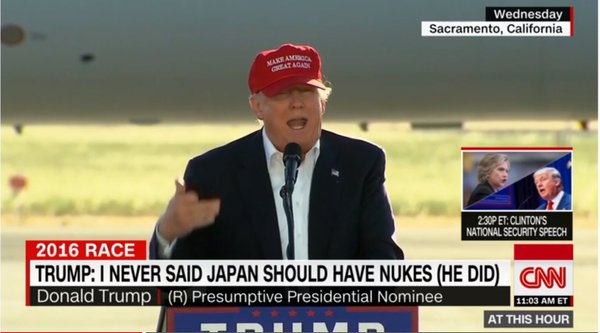On Thursday morning, a fact-checker’s fantasy world materialized live on air.
CNN’s “At this Hour” played a clip of Donald Trump in Sacramento swatting away allegations that he advocated that Japan obtain nuclear weapons. Turns out, those allegations were true, based on a statement the presumptive Republican nominee made earlier this year.
Highlighting a flip-flop on TV isn’t newsworthy; what made this segment relatively unique was the chyron below the clip of Trump’s speech from Sacramento, which read “Trump: I never said Japan should have nukes (he did).”
This choice received quite a lot of attention, at least among the media Twitterati.
Some speculated on the fate of the producer behind the move:
@Mantzarlis @AdrienSnk @CNN @Poynter @PandoDaily
Betting said producer is no longer working for CNN.
— Ralph Henson (@ralphhhenson) June 2, 2016
@Mantzarlis @Poynter @AdrienSnk @CNN right now there’s an EP staring down a producer: “Don’t you effing move.” 🙂
— Tom Wright (@StateStPosts) June 2, 2016
Many were pleased.
*high fives whoever’s working the @cnn graphics desk* https://t.co/EyKzueXGUn
— Mallory McMorrow (@MalloryMcMorrow) June 2, 2016
If you’re gonna cover someone, cover them responsibly. https://t.co/uQ799YXa6p
— Hannah Weinberger (@Weinbergrrrrr) June 2, 2016
Some noted excitement over the chyron was indicative of the state of the media.
It’s so depressing that “news org points out lie” is such a refreshing occurrence https://t.co/GsPtHDjkUs
— Rich Abdill (@blabdill) June 2, 2016
In the context of continued concern that we are living in a “post-fact world,” CNN’s chyron does seem to matter.
American television has been accused of not stepping up its game to combat misinformation in this election cycle.
In many ways, the failure has been one of formats rather than content. When TV hosts have tried to correct the record they have sometimes done so by replaying long clips of the claim with no clear indication of its falsehood. In other occasions, they have not done enough homework to shut down a lie when the candidate hits back — even if they were entirely correct.
Brendan Nyhan, assistant professor in the Department of Government at Dartmouth College, also found the CNN’s fact-checking chyron unique.
Nyhan, who has conducted several studies on fact-checking in recent years, found it “especially notable because cable news chyrons often reinforce misleading messages or create doubt over relatively settled questions.”
As an example, Nyhan cited Trump’s press conference on donations to veterans’ groups, during which CNN’s chyrons “often reinforced the message that he had made donations rather than the questions about whether he kept his word.”
Bill Adair, creator of PolitiFact and director of the Duke Reporters’ Lab, praised the effort.
“It’s great to see CNN using the chyron to tell the truth.” While seemingly secondary, words on the chyron “often have a larger audience of people who may have the sound down or pass a TV in an airport or doctor’s office.”
Mark Stencel, co-director of the Duke Reporters’ Lab, concurred. “It certainly shows the power of a news organization to express its authority without bias in two little words.”
As welcome as this use of the chyron was, two limitations emerge.
The first: This wasn’t a live overlay, as many on Twitter seemed to believe. Previous renditions of Trump’s Sacramento speech did not get the same fact-checked treatment.
Secondly, if CNN starts deploying chyrons for fact-checking and not mere captioning purposes, it will have to do so consistently across candidates. Otherwise, it risks further feeding the anti-media animus Trump and his supporters have vigorously expressed.
CNN has not responded to requests for comment on this article.






